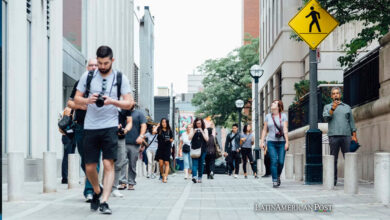The coronavirus could have originated in an exotic animal farm
A commission of scientists from the WHO traveled to China to find out the possible origin of the virus .

WHO investigates where the coronavirus originated in Wuhan, China. Photo: Wikimedia-Skoleopgave1
LatinAmerican Post | Moisés Campos
Listen to this article
Leer en español: El coronavirus pudo originarse en una granja de animales exóticos según la OMS
The World Health Organization (WHO) has been investigating the origin of the coronavirus. This is important in order to prevent other possible transmissions to humans. In this way, the necessary measures can be taken to prevent a pandemic from occurring again.
Origin of the coronavirus
An exotic animal farm located in southern China may have been the origin of the coronavirus. The information was provided by the president of the EcoHealth Alliance, Peter Daszak, who was part of the WHO research delegation that carried out the investigation into the origin of the virus at the beginning of the year.
Peter Daszak stated in an interview that was broadcast on NPR, that the group of WHO researchers who were in China, found evidence that exotic animal farms located in the south of the country were the ones that supplied the Huanan market in Wuhan, where the first cases were reported.
These farms where Daszak and the WHO researchers conducted their research earlier this year, as published in a Profile.com article, are located in the southern Chinese province of Yunnan, and there are even some that are located in Myanmar. There it could have caused the coronavirus to pass from a bat to another type of animal, and then make its jump to humans.
Exotic animal farms in China
Peter Daszak also believes that the coronavirus began its cycle of infections in southern China, taking into account that the country's government made the decision to close these markets in Yunnan, which have an important weight in the region's economy. The researcher pointed out that these farms have animals such as raccoons, bamboo rats or porcupines, that they reproduce in captivity, and supply to different markets in the country.
According to information collected by various newspapers, the Chinese authorities closed these farms in early 2020, as they considered them to be the possible source of contagion in Wuhan, where the first cases of the virus were detected. The WHO and the group of researchers agree with the Chinese authorities that this was the most likely form of infection.
In the Profile.com article, Daszak points out how before the coronavirus pandemic began, the exotic animal farm sector was one of the sources of prosperity in the region, receiving incentives from the Government, with the aim of favoring the economic growth of the rural population. In 2016 these farms generated around 70 billion dollars and were a source of work for 14 million people. But in February 2020, the government ordered their closure, as well as that the animals be eliminated, as a preventive measure.
The Government pledged to put an end to the raising of wild animals for use as food, instructing those in charge of these farms on how to dispose of the animals in a way that is safe for both staff and the population, thus avoiding the spread of new diseases, according to the Profile.com article.
How humans got it
The entire scientific community agrees that the origin of the virus is animal, but the factors that caused it to be transmitted to man are still unknown, according to Etienne Simon-Lorière, member of the Virology Department at the Pasteur Institute in Paris.
All the evidence indicates that the origin of the coronavirus is in the bat, which is considered a reservoir of the virus. However, the scientific community considers that the possibility of it passing directly to humans is very low, so it must also be determined which animal served as an intermediary.
The pangolin, an endangered mammal, is the animal that is believed to have served as an intermediary, but the WHO is conducting the necessary studies to verify this suspicion, while it continues to investigate other species of animals that were also sold in the Huanan market , according an article in El Universo.
The researcher Simon-Lorière believes that the intermediary must be an animal with a receptor for the virus very similar to that of humans. This receptor is a protein called ACE2, to which the virus attaches itself in order to enter cells. But according to the WHO, it may take a long time for this to be determined, and as Simon-Lorière points out in the article in The Universe, in the case of Ebola it has not yet been established.
Also read: COVID-19: Home tests could prevent infections and reduce deaths at a justifiable cost
Laboratory viruses
During the first wave of the pandemic, versions circulated stating that the virus could have accidentally escaped from a specialized laboratory in Wuhan, according to El Universo. Although the Chinese government has denied it, many people still support this theory.
The virologist Etienne Decroly, pointed out on the site of the French research center CNRS, that as long as the intermediary animal is not found, no other hypothesis can be scientifically ruled out. The virologist considers, however, that it is an unlikely idea, for all that it implies in itself.
The theory that experts have rejected is that the coronavirus was manufactured in a laboratory, because all the components of the virus genome have been found before in nature, especially in bat coronaviruses. Besides that, there is no proof that it was manufactured, as pointed out by Simon-Lorière.
WHO report
During the next few weeks, the WHO is expected to present a report with the conclusions reached by the experts who are investigating the origin of the coronavirus pandemic. According to Daszak, at this point it is essential to be able to identify the species and the farm from whence the virus originated.
The group of experts led by the WHO includes prestigious specialists from Australia, the United States, Japan, Russia, Germany, Qatar, the United Kingdom, the Netherlands and Vietnam, who in January traveled to the city of Wuhan, where the first outbreak of the virus appeared, according to the Profile.com article. The experts held meetings with Chinese colleagues and met with health personnel and residents of the area, and visited the Wuhan meat and seafood market.
Determining what was the origin of the coronavirus and even being able to establish which was the intermediary animal, is essential to create mechanisms that allow to prevent and face new viruses that could give rise to another pandemic.




